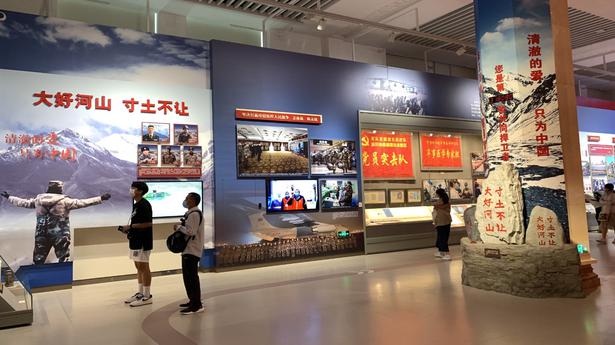
PLA museum highlights 1962, Galwan clashes
The Hindu
The museum also displays a “Karakoram stone” sent from the border by the PLA, and visitors are encouraged to press a button to show their support
A new exhibition curated by China’s People’s Liberation Army (PLA) in Beijing’s Military Museum and visited by President Xi Jinping last month has highlighted both the 1962 war and the Galwan Valley clashes, and cast the blame on India for both.
Both 1962 and Galwan are featured in exhibits in the sprawling exhibition in the Military Museum, which has attracted large crowds in Beijing since its reopening to the public on Tuesday. The exhibition showcases 95 years of the PLA’s history, and particularly highlights the reforms of the Xi era. Mr. Xi visited the exhibition on July 28, days before the 95th anniversary of the PLA which fell on August 1.
The main focus of the PLA exhibition is on Mr. Xi’s contribution, which is placed on a par with Mao, in shaping the PLA, which is unique among militaries in being the armed forces of a political party. Of the four sections of the exhibition, one is dedicated to Mao and one to Xi. One section focuses on the PLA’s early history from its founding in 1927 to the establishment of the People’s Republic of China in 1949, while a fourth section lists the contributions of former leaders Deng Xiaoping, Jiang Zemin and Hu Jintao together.
The section on Mr. Xi’s era is the largest. Among the exhibits that highlight the military’s modernisation are a panel on the Galwan Valley clash on June 15, 2020, and tributes to PLA soldiers who died in the clash.
The exhibits have underlined how border tensions with India are receiving more prominent attention in China than previously. Ahead of the 60th anniversary of the 1962 India-China war which falls in October, official Chinese military researchers have also compiled a new history of the war, describing it as a “forgotten” war after being downplayed for years, unlike the wars with Japan or in Korea, as ties with India warmed.
There is also an exhibit on the 1962 war, which blames India for the conflict, completely turning on its head the events that led to China’s massive attack on India in October 1962.
“China and India have never formally demarcated their borders in their past. There is only a traditional customary line formed according to the administrative jurisdiction of both sides,” it says. “ After August 1959, the Indian army invaded Chinese territory many times, causing armed border conflicts. In October 1962, the Indian army launched a large-scale attack and Chinese border defence forces were forced to flight back in self defence. It lasted 33 days and the military recovered the Chinese territory occupied by the Indian army after August 1959.”













